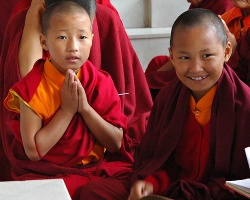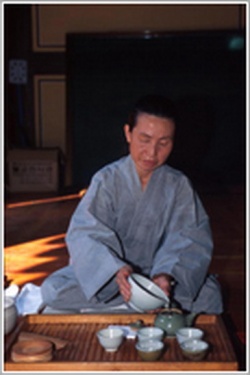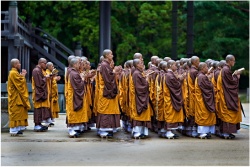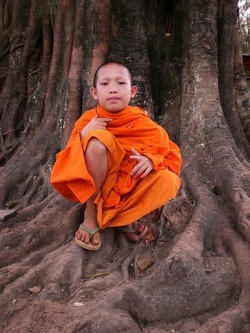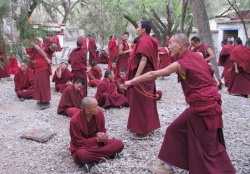Sangha, 24 Definition(s)
Lit., harmonious community. In the Buddhadharma, Sangha means the order of Bhiksus, Bhiksunis, Sramaneras and Sramanerikas. Another meaning is the Arya Sangha, made up of those individuals, lay or monastic, who have attained one of the four stages of sanctity. Also, the Bodhisattva Sangha.
A general term that refers to the monks (Bhikkhus) as a whole.
Community, a chapter of (not less than four) Buddhist monks, the Order
On the conventional (sammati) level, this term denotes the communities of Buddhist monks and nuns; on the ideal (ariya) level, it denotes those followers of the Buddha, lay or ordained, who have attained at least stream entry (see sotapanna), the first of the transcendent paths (see magga) culminating in nibbana. Recently, particularly in the West, the term "sangha" has been popularly adapted to mean the wider sense of "community of followers on the Buddhist path," although this usage finds no basis in the Pali canon. The term "parisa" may be more appropriate for this much broader meaning.
A word with several associations. One meaning refers specifically to the Aryasangha (Pali Ariyasangha -- those who have attained to the supramundane Path). Another meaning is the patimokkha sangha -- the community of ordained monks and nuns. Western Mahayanists sometimes use the word in yet a third sense, to refer to the "mahasangha" -- the community of all believers. The Sangha that is referred to in the Triple Gem is the Ariyasangha; from an orthodox viewpoint (whether Theravada or Mahayana), beings who have not cut off the defilements are not a satisfactory object of refuge.
The Buddhist monastic order. The corporate assembly of at least 3 monks under a chairman, empowered to hear confession, grant absolution and ordain. In general terms, it refers to any community practising the Buddhist Way.
A general term that refers to the monks (Bhikkhus) as a whole.
community; assembly. Often used for the order of bikkhus and bhikkunis in Theravadin countries. In the Mahayana countries, the Sangha includes lay devotees and priests, e.g. in Japan.
(Pali) On the conventional (sammati) level, this term denotes the communities of Buddhist monks and nuns; on the ideal (ariya) level, it denotes those followers of the Buddha, lay or ordained, who have attained at least stream entry.
A word meaning community or congregation. In Buddhism it refers primarily to the community of saints and enlightened ones (Ariya Sangha), the third of the three Jewels and the three Refuges, and the order of monks (bhikkhu Sangha) and nuns (bhikkhuni Sangha). However increasingly the word is now being used for the Buddhist community in general, spiritually developed or not, ordained or not.
The community of practitioners of the Buddhist path, or those beings who have attained direct realization of the nature of reality, one of the three jewels of refuge.
SANGHA (Skt.; = Tib. gedun). For the Theravadins, this term refers specifically to the monastic community. For Mahayana Buddhists, it is extended to include lay practitioners.
The sangha is the community of Buddhists.
According to the Vinaya tradition, any community of four or more fully ordained monks or nuns. In general, ordained or lay people who take Bodhisattva vows or Tantric vows can also be said to be Sangha. See Joyful Path of Good Fortune.
community of disciples within a monastic order (Sanskrit)
The spiritual community of those sincerely following the same spiritual path. According to the Vinaya tradition, any community of four or more fully ordained monks or nuns. In general, ordained or lay people who take Bodhisattva vows or Tantric vows can also be said to be Sangha.
1. Sangha. An astrologer (samvacckarikanayaka) who predicted the destiny of Kitti (afterwards Vijayabahu I.). It was this prediction which made Buddharaja support Kitti. Cv.lvii.48.
2. Sangha. Father of Suranimmila; he was the father of seven sons and lived in Khandavitthika. Mhv.xxiii.19.
3. Sangha. An upasaka who will wait on Metteyya Buddha (Anagat. vs. 61) and be his chief lay patron. Ibid., 98.
4. Sangha. A minister of Dutthagamani. He gave alms, in circumstances that won applause from the deity of the kings parasol, to Mahanaga Thera of Kotagallapabbata, to a monk of Timbarugama, and to another of Devagirivihara and Cetiyapabbata. The king sent for him and made him Treasurer. It is probably this same Sangha that is mentioned in the Extended Mahavamsa (xxxii.246) as destined to become the chief patron of Matteyya Budda. His wife was Sanghadatta (q.v.). Ras.ii.75f, 180.
5. Sangha. A minister of Kakavannatissa; his brother was Cullasangha and his daughter Kincisangha. When the latter was taught cooking, the first meal she made was given to the monks. Thus she came to be called Sanghupatthayika. Later, she was abandoned by her parents at Nigrodhasalakhanda, but she was rescued by Sakka in the guise of a youth. She gave alms to a monk of Cittalapabbata when she had been starving for seven days, and also gave her only garment, herself wearing leaves. The king heard of this from the deity of his parasol, and, having sent for her, gave her in marriage to one of his sons. Ras.ii.45f.
Sangha Sutta. The Buddha tells Upali of ten things which disunite the Order and their ten opposites which unite it. A.v.73.
1. Sangha Theri. She belonged to Prince Siddhatthas court, and having joined the Order with Pajapati Gotami, became an arahant. Thig. vs. 18; ThigA.24.
2. Sangha. Daughter of Mahanama and step sister of Sotthisena. She killed Sotthisena and gave the kingdom to her husband, who was his umbrella bearer, but he died within a year. Cv.xxxviii.1f.
3. Sangha. Wife of King Manavamma. She was the daughter of the Malayaraja Sanghasena. Cv.xlvii.3, 8.
4. Sangha. Daughter of Aggabodhi VI. and wife of Aggabodhi VII. Her husband once struck her in anger, and, when she complained to her father, he sent her to a nunnery. There her maternal cousin, also called Aggabodhi, became friendly with her and ran away with her to Rohana. But her husband made war on him and seized both him and Sangha. After that husband and wife lived in peace. Cv.x1viii.54ff.
5. Sangha. Mahesi of Sena I. She and her husband built the Pubbarama and the Sanghasenarama in the Mahavihara. Sangha also built the Uttara vihara and the Mahindasena parivena. Cv.l.7, 69, 79.
6. Sangha. Daughter of Kittaggabodhi and Deva and wife of Sena II. She had a son (Kassapa V.).
Community of bhikkhus, established by Buddha.
The raison detre of the sangha is to transmit the sasana and to preserve it. To do so, the mode of functioning of this community is entirely ruled by the vinaya that the Perfect one has established. If such wasnt the case, his teaching would have disappeared since quite long. It could have never, twenty five centuries after Buddhas parinibbana, been still brought to the acknowledgement of mankind, neither being practised, nor being realised.
Remark: We most often see this word written as "sangha" instead of "sangha". It is however a mistake. In accordance with the Pali transcribing or transliteration, the combination "san" does not exist, or then we do obtain "sa + ngha", which calls for a different pronunciation (close to "sana").
the community of those who practise the Buddhas Way. More specifically, those who have formally committed themselves to the lifestyle of a mendicant monk or nun.
Sa"ngha: Community. In this Vinaya book it usually refers to the Bhikkhu Community, either of a specific place or as a whole. There must be a local community of at least four bhikkhus before it is a Sa"ngha. (It is also, of course, the third of the Three Gems and the Three Refuges where it applies to the ariya sa"ngha.)
Sanskrit; a term for the Buddhist monastic community which has recently come to include the entire community of Buddhist practitioners; it is considered one of the three jewels of Buddhism (along with the Buddha and the Dharma).
(lit.: congregation), is the name for the Community of Buddhist monks.
As the third of the Three Gems or Jewels (ti-ratana) and the Three Refuges (ti-sarana), i.e. Buddha, Dhamma and Sangha, it applies to the ariya-sangha, the community of the saints, i.e. the 4 Noble Ones (ariya-pugga), the Stream-winner, etc.
the Buddhist community, either specifically monks or all who practice.
Sangha (samgha), Skt., lit., “crowd, host”; the Buddhist community. In a narrower sense the sangha consists of monks (bhikshu), nuns (bhikshunī), and novices (shrāmanera). In a wider sense the sangha also includes lay followers.
